With its migrant-inspired cuisine, omnipresent earthy flavours, and giddy aromas, Mauritius offers a delectable slice of the Indian Ocean’s multicultural history.
By MEENAKSHI J

Palatial châteaux, ornately vibrant Hindu temples, vast fields of swaying sugarcane, charming museums, and a rich motley of cultures—the African nation of Mauritius is a delight for the senses. Beyond the quintessential island sights and sounds, this paradise has many delicious surprises in store for me. Quite literally, as its mixed Mauritian cuisine embodies flavours and aromas imbibed from divergent traditions created over centuries of immigration. On a trip to Maurice (as the island is fondly called by the locals), I find that wayfarers and colonists—from the Arabs and Dutch to the French and British—have left their mark on the isle’s culinary scene. Yet, it’s the indelible flavours brought by migrants from India, China, and Africa that still linger on in the country’s gastronomy. And Port Louis, the capital city, is a veritable starting point for my flavourful explorations.
FROM DHOLL PURI TO PANI PURI
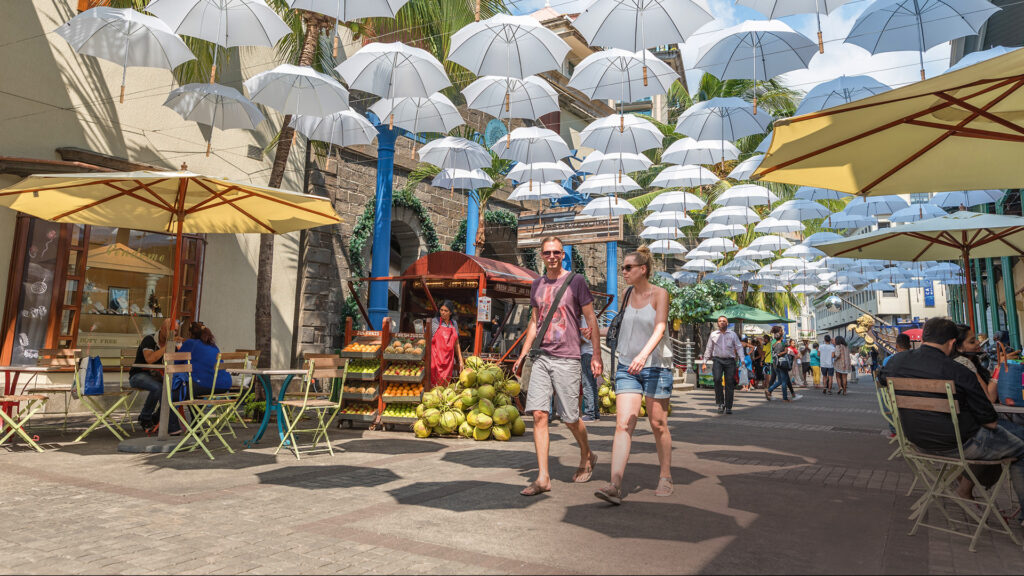
Caudan Waterfront sidewalk in Port Louis.
My gastronomic odyssey began at the bustling Caudan Waterfront in Port Louis—a famous upscale esplanade and beloved shooting spot of several Indian filmmakers.
I was surprised to find the surrounding cobbled promenade lined with kiosks doing brisk business, selling a range of street food—from dholl puri to pani puri (type of bitesized Indian chaat). The sellers try to grab the attention of all visitors, their sales pitch seamlessly switching languages between Creole and French. Of course, many also break into a beautiful mixed dialect of Bhojpuri and Hindi upon seeing Indian travellers like me. I gave the irresistible pani puri a miss and, instead, bought myself a dholl puri—a dish I later realised is found ubiquitously across the island. For the uninitiated, this is actually ‘dhal puri’ (a sort of roti), stuffed with a mixture of soaked and ground yellow split peas (chana dal), mixed with cumin and turmeric, and shallow fried on a tawa (flat pan). This crepe is either served as is or rolled and filled with cari gros pois (butter bean curry) and rougaille (a saucy tomato Creole dish), and served with coriander satini (chutney). It’s warm, soft, and flaky, and I relished every bite of it! Served with atchar (pickle) and sold by a Bhojpuri-speaking lady and her daughter, it tasted so familiar yet so Mauritian, owing to the minimal spices used.
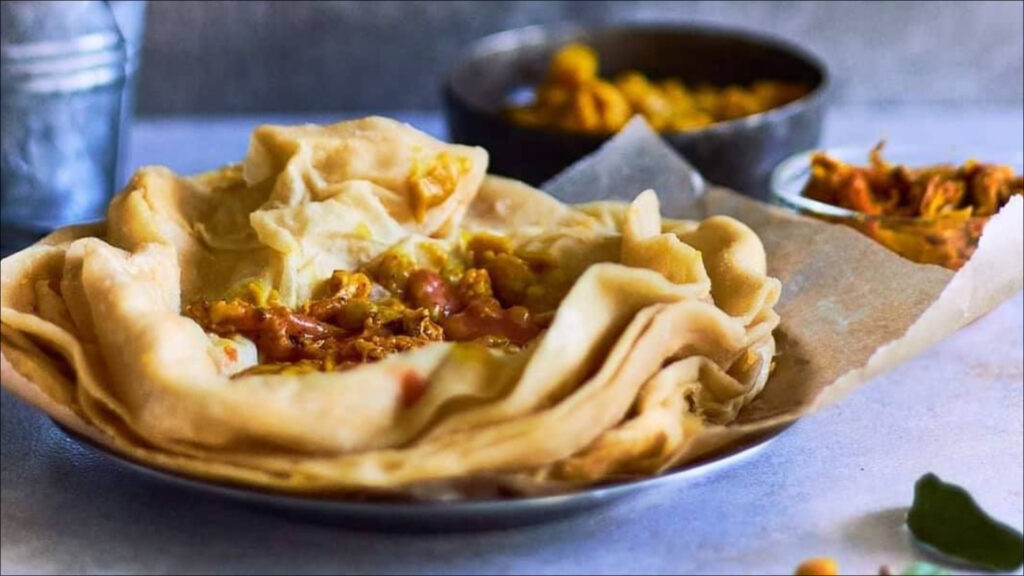
Just beside the dholl puri stall, an Indian couple was selling freshly fried Gateaux Piment that tasted much like the masala vadai of Tamil cuisine. Not surprising as both are made of soaked and ground split yellow peas, combined with chopped green chillies and coriander leaves. Only difference being that the latter is fried as a flattened savoury, while the Gateaux Piment is rounded into balls.
I washed down a couple of Gateaux Piment with a glass of alouda—a Frenchified word for Indian falooda (a cold dessert made with vermicelli noodles)—from an adjacent stall that also stocked fresh fruit juices.
Although I sampled only the vegetarian dishes of Indo-Maurice cuisine, the country is obviously very popular for its non-vegetarian fare. And one can find umpteen food stalls selling chicken and mutton biryani as the Mauritian briani, served with Mazavaroo paste made with fiery red chillies, and green satini. Another favourite is the farata (similar to the Indian paratha) paired with an Indian flavoured Mauritian curi (curry), Creole-inspired Cari Poule (chicken curry), or duck and octopus curi.
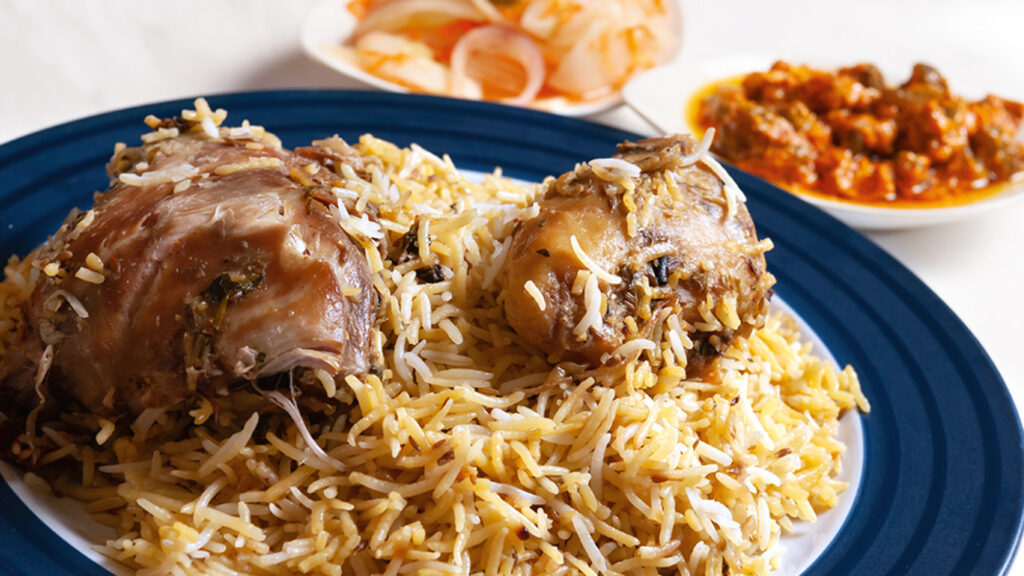
A BITTERSWEET PAST
So, how did these Indian migrants land in Mauritius, bringing with them the flavours of the subcontinent? I found my answer at the UNESCO heritage site of Aapravasi Ghat, on the bay of Trou Fanfaron in Port Louis. Nearly half a million Indians landed here in 1829. They had signed a contract agreement with the colonists, in pursuit of land just a little way off from India, but were instead sent on a long, arduous sea journey to work on the sugarcane farms of Mauritius.
Back in the day, the Dutch brought sugarcane, tobacco, and citrus fruits to the island, the French taught bread- and stew-making to the locals, and the Chinese brought with them varied sauces and mine frite or fried noodles. Even today, much of the agricultural land here is covered by sugarcane fields owned by French people, but enriched by the sweat of migrants and the island’s red volcanic soil. The labourers who once worked on these plantations largely consisted of people from India’s Bihar and Tamil Nadu. And, of course, they brought with them spices, pickles, and traditional recipes to make flavourful curry!
THE SEPT CARI EXTRAVAGANZA
My next stop on this road trip along the western coast of Mauritius was at Pointe aux Piments—a littoral fishing hamlet tucked between Port Louis and the touristy Grand Baie village in the north. The landscape of this beachfront neighbourhood merged into a blanket of undulating sugarcane fields outlined by fronds of coconut trees. And the backdrop of the mighty Indian ocean was as vibrant as ever.

Here, I enrolled in a Mauritian cooking session at the Le Méridien Ile Maurice. This turned out to be a delicious chapter to understand the island’s kaleidoscopic culture.
“We prepare the Sept Cari on auspicious occasions and marriage ceremonies in Mauritius,” said Makend Shiv Hum, chief chef at the hotel, as he introduced us to the isle’s signature Sept Cari meal. As a local Mauritian and migrant, whose ancestry stems from the state of Bihar in India, Chef Makend is one of a handful of cooks to have successfully recreated a fascinating and unique fusion cuisine, with inspirations from India, but whose flavours are definitely rooted in Mauritius. Influenced greatly by the cuisine of South India, the mouthwatering Sept Cari meal turned out to be a gastronomic extravaganza that tantalised all the six senses akin to the arusuvai unavu (the six essential flavours) of Tamil cuisine.
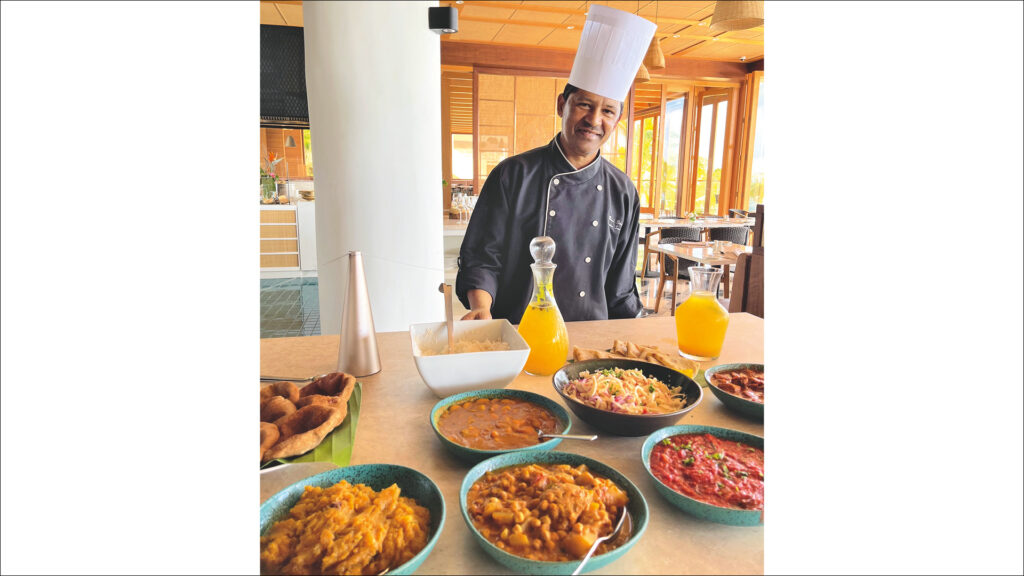
Each of the dishes is served in a pre-decided order on fresh plantain leaves and traditionally eaten with fingers. It is especially prepared during Tamil festivals like Thaipoosam Cavadee (Full Moon Festival), celebrated in the month of January, as well as on special occasions and through the wedding season.
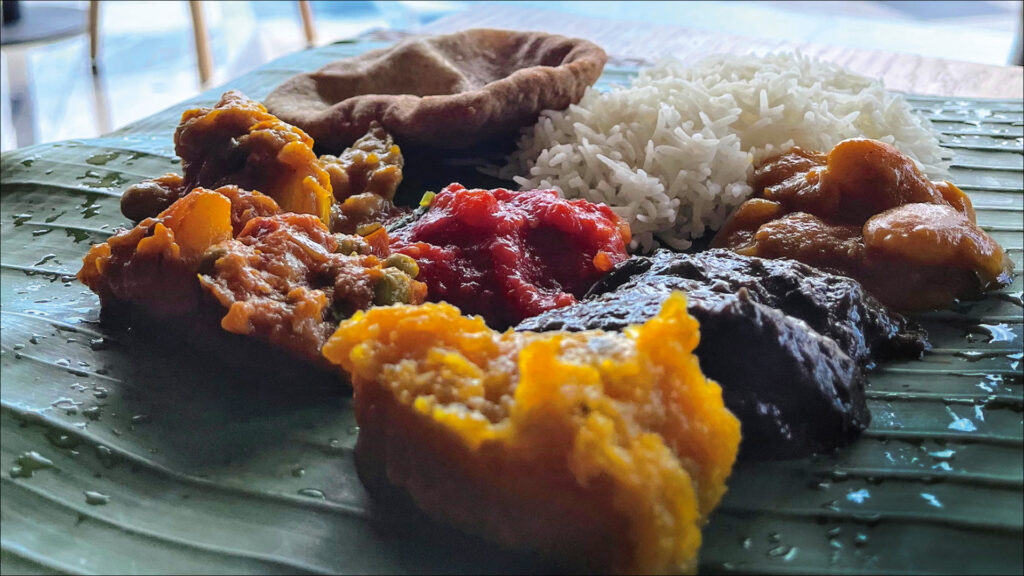
“The Tamil Sept Cari has a coconut flavour to its dishes,” adds Tejal Seebhujan, an Indian married to a local Mauritian, who frequents the cooking class, “while the Hindu (non-Tamil) meal rarely ever uses any grated coconut.”
Makend explains that the name Sept Cari stems from the ‘seven curries’ that are part of the festive spread. These comprise several vegetable preparations served along with steamed rice and puri. The seven curries include the saucy Creole dish rougaille (given a Mauritian twist with vegetables cooked in spices and coriander); shredded, spiced, and stir-fried raw jackfruit, also known as cari zak; green beans cooked in a spice blend called haricots masala; plain dal or dal brinzel, a version of the Tamil brinjal sambhar; grated raw banana sauteed with spices and turmeric or cari banane—akin to the Chettinad poriyal; pomme de terre masala or masala potato curry; and ziromon touffer, which is pumpkin cooked in spices. These dishes are accompanied by Mauritian condiments like kutcha (mangobased pickle) and achard legume (pickled mixed vegetables).
AN EXOTIC FINALE
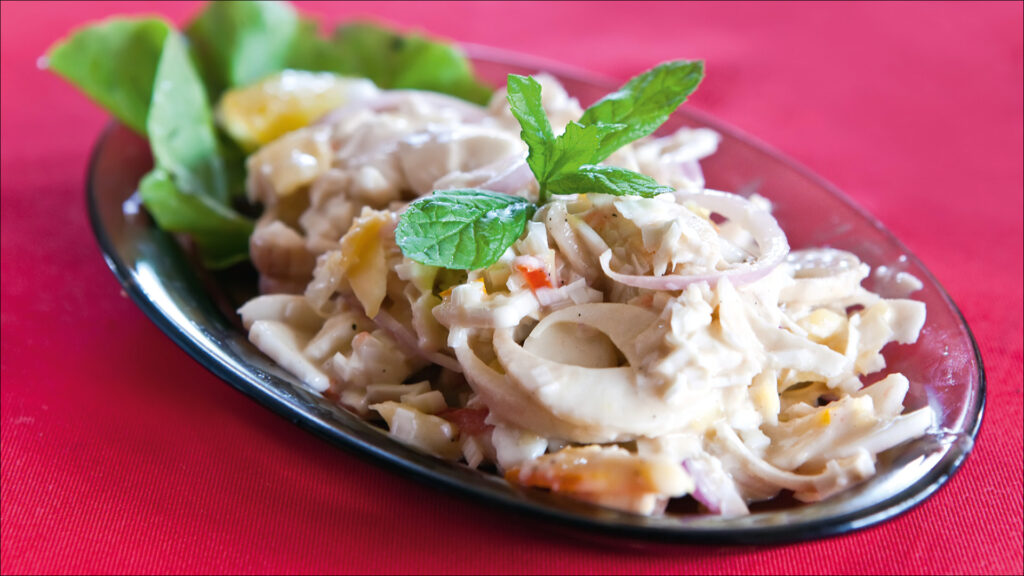
In addition to the dishes of the Sept Cari meal, I tried my hand at putting together an indigenous culinary innovation on this trip. Chef Makend introduced me to the local favourite ‘COEurs de Palmier’—also known as the heart of palm. This comprises the delicate and flavoursome inner core of a palm tree, and is used in putting together the highly loved Palm Heart Salad, loaded with nutritional elements. After slicing the palm cores, I tossed them with salad leaves and seasoned them with lemon juice and vinegar to make the exotic preparation. The salad seems to have gotten its name from the labour-intensive harvesting that’s needed for the heart of palm. The tree must grow for at least seven years before its trunk is cut and its inner white core utilised to make this salad!
It’s just one more of the many exotic wonders tightly packed into this tiny island-nation! And as I reslished the sweet-savoury flavours of yet another delectable dish, I realised that whether its dholl puri or pani puri, Sept Cari or the Millionaire’s Salad (the Mauritian name for Palm Heart Salad), the food in Mauritius is truly an Indo-African potpourri.
GETTING THERE
Vistara offers direct flights five times a week between Mumbai and Mauritius.
Related: 7 Lip-Smacking Dishes From Goa You Must Try At Least Once In Your Life!




